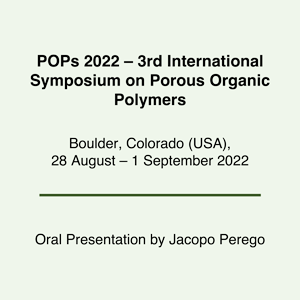Boulder, Colorado (USA), 28 August – 1 September 2022, Oral Presentation by Jacopo Perego
Title: “Engineering Porous Organic Polymers with Light-Responsivity, Luminescenceand Tailored Host-Guest interactions”
Authors: J. Perego, C. X. Bezuidenhout, S. Bracco, P. Sozzani and A. Comotti
Abstract
The design and engineering of precise molecular building blocks expand the scope of porous materials and boost the development of innovative photonic, dynamic, and adsorptive materials. Light-responsive Porous Switching Frameworks (PSFs) with BET surface area as high as 3948 m2 g-1 were generated by co-polymerization of molecular motors with rigid tetrahedral building blocks.[1] The quantitative molecular photoisomerization in the solid state promotes the modulation of gas adsorption properties, generating light-responsive materials suitable for actively switching devices. Self-standing sensitized triplet-triplet annihilation (s-TTA) upconverting nanoparticles were developed by inclusion of a porphyrin unit (sensitizer) in the cavities of Porous Emitting Frameworks (PEFs) comprising highly luminescent diphenyl anthracene (DPA) units.[2] The proximity between the guest sensitizer and DPA emitters promotes effective energy transfer and an up-conversion quantum yield as high as 0.15, a record value for solid-state materials. Porous Aromatic frameworks (PAFs) provide a stable platform with ultra-high pore volume. Highly reactive anionic species were generated on the framework or diffused in the pores to promote anchored and confined polymerization.[3] The “ship-in-a-bottle” polymerization process generates intimately interdigitated nanocomposites proved by 2D 13C solid-state NMR. Moreover, the living nature of anionic polymerization allowed the fabrication of polymer-coated nanoparticles with sequential architecture. The adsorptive properties of POPs can be tailored for selective gas adsorption: calixarene-based POPs provide great opportunity for gas storage and separation proved by high-pressure sorption, adsorption-coupled calorimetry, and breakthrough measurements under flow condition.[4] References [1] F. Castiglioni, W. Danowski, J. Perego, F. K.-C. Leung, P. Sozzani, S. Bracco, S. J. Wezenberg, A. Comotti, B. L. Feringa, Nat. Chem. 2020, 12, 595–602. [2] J. Perego, J. Pedrini, C. X. Bezuidenhout, P. E. Sozzani, F. Meinardi, S. Bracco, A. Comotti, A. Monguzzi, Adv. Mater. 2019, 31, 1903309. [3] J. Perego, S. Bracco, A. Comotti, D. Piga, I. Bassanetti, P. Sozzani, Angew. Chem. Int. Ed. 2021, 60, 6117–6123. [4] A. Pedrini, J. Perego, S. Bracco, C. X. Bezuidenhout, P. Sozzani, A. Comotti, J. Mater. Chem. A 2021, 9, 27353–27360.

